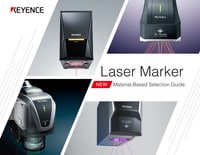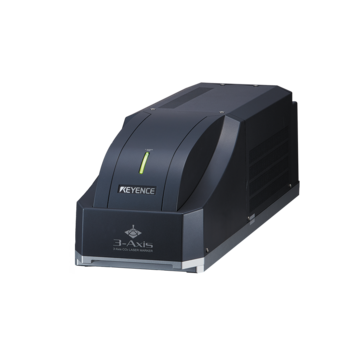Industrial Laser Marking Systems / Laser Markers
The 3 Most Common Types of Laser Marking
-
Tags:
- Laser Marking , Laser Etching , Laser Engraving
Laser marking is an umbrella term for creating a design on a surface with a laser beam. Within this general term, manufacturers can access a range of possibilities with types of laser marking machines and processes. For instance: engraving, oxidizing, annealing, and etching are marking methods used by many common types of laser markers.
Unfortunately, there is no one-size-fits-all when it comes to laser marking. However, some types of laser marking processes are more popular than others because of their versatility. Common types of laser marking applications being used by manufacturers include engraving, color marking, and traceability marking.
Laser Engraving
Laser engraving is a method of marking where a focused laser beam carves a design into a material’s surface. The indented marks are created by evaporating the surface. Four types of lasers are used for engraving: UV, fiber, CO2, and hybrid. Each of the different types of laser engravers is ideal for different materials, products, and industries.
Types of Laser Engravers: UV
UV laser engraving uses ultraviolet light and high absorption to mark materials. The UV laser engraving process is known as “cold marking” because it does not add heat stress or burn the material. The laser marking machine creates a UV beam using two nonlinear crystals as the passageway. It shoots a 1064 nm laser beam through the crystals to convert the beam to a 355 nm laser.
- UV Laser Marking vs. Different Types of Laser Engravers
- Manufacturers often choose UV over other types of laser engravers because it marks well on heat-resistant and heat-sensitive materials. It has a strong enough beam to evaporate heat resistance materials, but the cold marking technique prevents heat stress on heat-sensitive materials. Not only that, but UV laser marking outperforms other types of laser engravers on highly reflective materials like copper, silver, and gold.
| UV Laser Marking: Materials | UV Laser Marking: Products | UV Laser Marking: Industries |
|---|---|---|
|
UV Laser Marking: Products
|
UV Laser Marking: Industries
|
Types of Laser Engravers: Fiber
Fiber engraving gets its name from the fiber resonator intensifying the 1090 nm laser beam. The fiber resonator makes fiber laser machines have notably high output power and engraving speed.
- Fiber Engraving vs. Different Types of Laser Engravers
- Fiber engraving is the best choice when looking to achieve significant depth on metal products due to its high output power. UV and CO2 types of laser engravers cannot achieve the high contrast marks or deep engraving on metals that fiber lasers can. These deep and high contrast marks withstand painting and corrosion, which is perfect for parts exposed to harsh environments.
Additionally, the high output makes fiber laser engraving a speedy process for repeated tasks. However, the high output can be damaging to heat-sensitive surfaces.
| Fiber Engraving: Materials | Fiber Engraving: Products | Fiber Engraving: Industries |
|---|---|---|
|
Fiber Engraving: Materials
|
Fiber Engraving: Products
|
Fiber Engraving: Industries
|
Types of Laser Engravers: CO2
CO2 laser engravers work by generating plasma and CO2 gas inside of a tube, amplifying that light between a reflective mirror and output coupler, and then output as a laser beam. The output laser beam has a wavelength of 10600 nm.
- CO2 Engraving vs. Different Types of Laser Engravers
- CO2 engraving machines have the longest wavelength of all lasers, so they have the most heat transfer. Some materials benefit from heat transfer because of their high heat resistance, while others, like metal, cannot physically be marked by CO2 lasers. Shallow engraving is ideal for materials that do well with CO2 engraving.
| CO2 Engraving: Materials | CO2 Engraving: Products | CO2 Engraving: Industries |
|---|---|---|
|
CO2 Engraving: Products
|
CO2 Engraving: Industries
|
Color Marking
Black Annealing
Annealing, also known as carbon migration, is a style of laser marking that is extremely popular in the aerospace and medical industries as it leaves behind a mark that is highly contrasting and easy to see, but does not raise the surface of the material or create any depth, thus allowing parts to still meet tight surface finish specifications and tolerances. This is achieved by de-focusing the laser to spread the heat over a wider beam spot. This act pulls the carbon content of the material to surface level, creating a visible mark.
This marking style is achieved only on ferrous materials.
Dark Marking
Dark marking, often referred to as oxidizing, is the act of burning the top layer of material to create a dark contrasting mark. This is extremely common on metal surfaces and often creates a mark that raises the materials surface.
White Marking
A white marking, also known as an etch, is achieved via light surface roughening of a component. The roughened surface alters the materials' reflectivity producing a white contrast. This white marking can be achieved by each type of laser, depending on the target material.
Curious about our pricing?
Click here to find out more.

Learn More About Different Types of Laser Machines
While this blog talks about common types of laser marking methods, many more types of laser abilities and machines are available. For example:
- Laser cutting
- Laser drilling
- Laser measurement systems
- Laser etching
- Laser printing
- Laser stamping
- Laser cleaning
Nevertheless, engraving and color marking are widely used across materials, products, and industries. There are many uses in these types of laser marking categories, from using a CO2 laser for engraving to a fiber laser for annealing.
If you’re looking for more information about lasers, whether that be types of laser marking, types of laser engravers, or different types of laser machines, ask KEYENCE!
At KEYENCE, we specialize in laser technology. Our laser technology is used in measurement devices, marking devices, microscopes, and more. Regardless of your industry, prior laser knowledge, or manufacturing goals, we are here to help you learn more about lasers! Contact us today to learn more information about different types of laser machines.
Discover more about this product.
Click here to book your demo.










